“Temple Attendants” has been added to your cart.
View cart
-
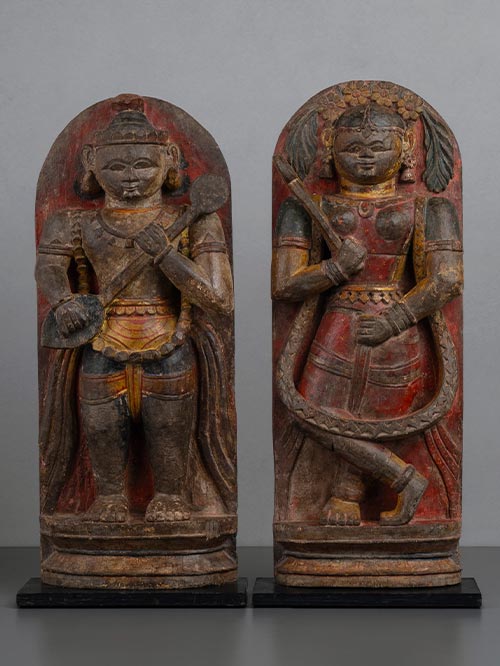
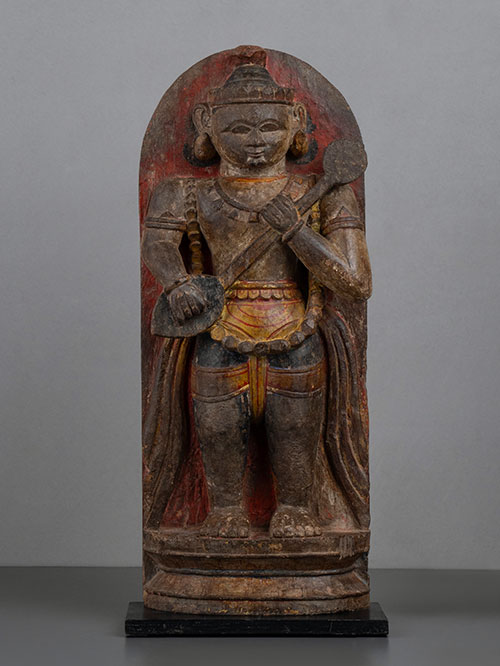
Orissa
Wood, polychromed
This beautiful pair of richly polychromed brackets depicts a musician carrying a string instrument and an attendant figure holding a chauri (fly-whisk). Standing on stepped bases, both figures are adorned with rich garments and wear long floral garlands. These figures likely originated from a natamandir, an addition to the shrine often adorned with sculptures of Devadasis and musicians.
Size (cms): 50(H) x 21(W) x 10(D)
Size (inches): 19.5(H) x 8.5(W) x 4(D)
-
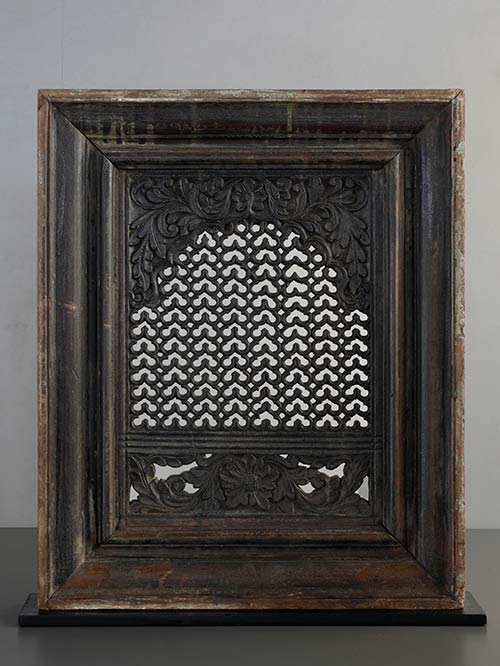

Deccan
Wood
An enchanting play of light and shadow is created from this jali or lattice window. Ideal during the hot humid Indian summer, the jalis dispel the harsh rays of the sun and allow a cool breeze to circulate indoors. Moreover, the purdah- conscious women used the jalis of their balconies and terraces to enjoy an outside view, without being seen themselves by the public.
Wooden construction was once widespread throughout most of Southern India, but the intense heat and the severe monsoonal rains have meant that a large proportion of the wooden buildings in private and public use have now disappeared. The typical southern Indian wooden building, was supported on a framework of columns, with an elaborate system of interlocking brackets and beams to support the floors and roofs. Carved doors, windows, and screens and panels filter light and ventilate the interiors, creating an environment that is both comfortable and richly detailed. The scale and shape of houses was dictated by the maximum height and span of timber beams, resulting in a modular system of construction. The woodwork was deeply cut and naturalistic, the intention of the artisans was to capture the forms and energies of the natural world.
Size (cms): 63(H) x 54(W) x 11(D)
Size (inches): 25(H) x 21.5(W) x 4.5(D)
-
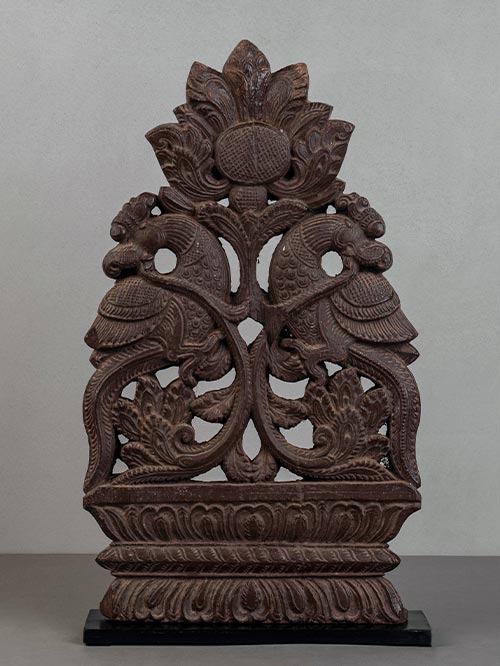
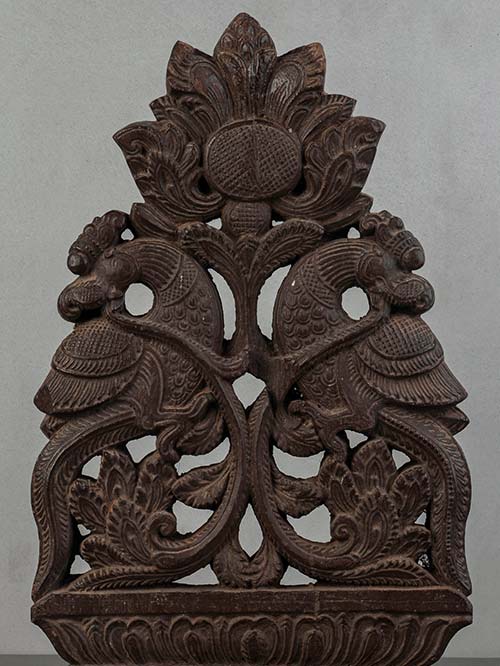
Mysore (Karnataka)
Wood
This unusual pierced panel portrays a pair of mythical Sharabhas perched atop swirling foliage, resting on a double lotus base. The mythical creatures, half-lion and half-bird, are delicately carved with scaly bodies and attractive patterned plumage. Their mouths are depicted spewing vegetation.
In Hindu mythology, Sharabha’s are a composite beast, part-lion and part-bird. Within Sanskrit literature, it initially appeared as an aggressive beast that roamed hilly and forest areas, clearing entire valley’s with a single jump. The mythological creature was later associated with Shaivism, appearing within some Puranic texts as a powerful incarnation of Shiva who assumes the form to pacify Narasimha – the fierce man-lion avatar of Vishnu worshipped by Vaishnava sect. Within Buddhist theology, Sharabha appears in Jataka Tales as a previous birth of the Buddha.
Size (cms): 50(H) x 29(W) x 9(D)
Size (inches): 19.5(H) x 11.5(W) x 3.5(D)
-
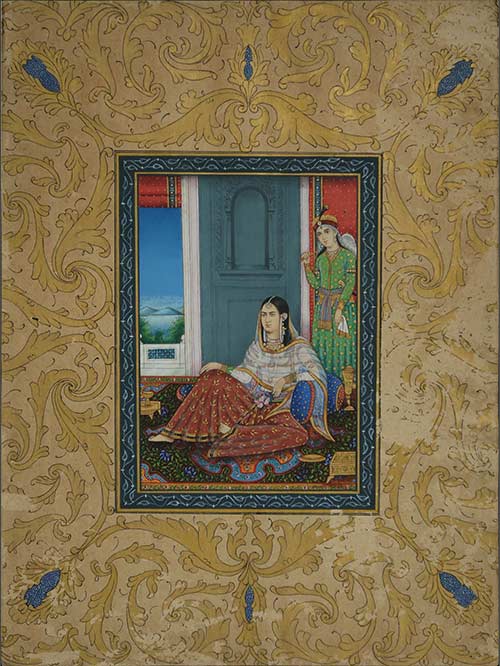
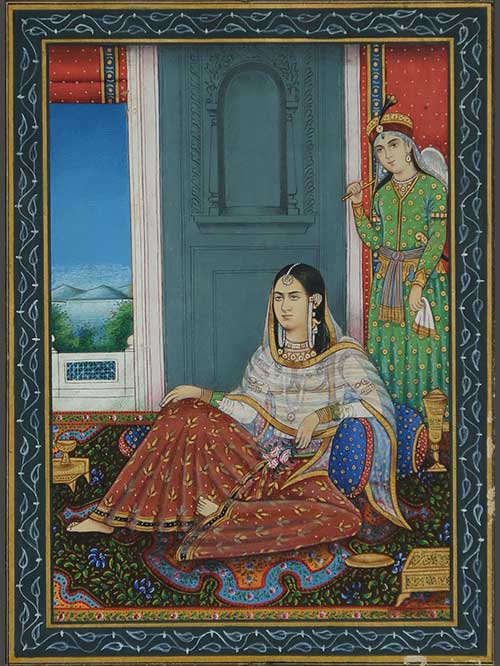
Delhi
pigments and gold on paper, painted gilt arabesque borders
A finely painted portrait of a seated lady, most likely a courtesan, as suggested by her stance and attire. She wears loose fitting pyjamas and a bodice under a diaphanous odhani or veil and is seated against a large blue bolster. A female attendant stands behind her holding a fly-whisk. Assorted gilded cups and a betel box are placed beside her on an intricately patterned floral carpet. A scene of a moonlit lake and hills visible in the distance through a marbled balcony.
Courtesans (tawaifs) occupied an honoured place in the Muslim cultures of India, especially in Lucknow and Delhi. They were trained to be women of great refinement, skilled in music and dancing and appreciative of courtly literature in Persian and Urdu. Their company was eagerly sought by the great men of Delhi, and they would entertain their visitors by performing a nautch (dance).
Miniature Size (cms): 18.3 (L) x 13.5 (W)
Miniature Size (inch): 7.2 (L) x 5.3 (W)
Page Size (cms): 33.5 (L) x 25 (W)
Page Size (inch): 13.2 (L) x 9.8 (W)
-
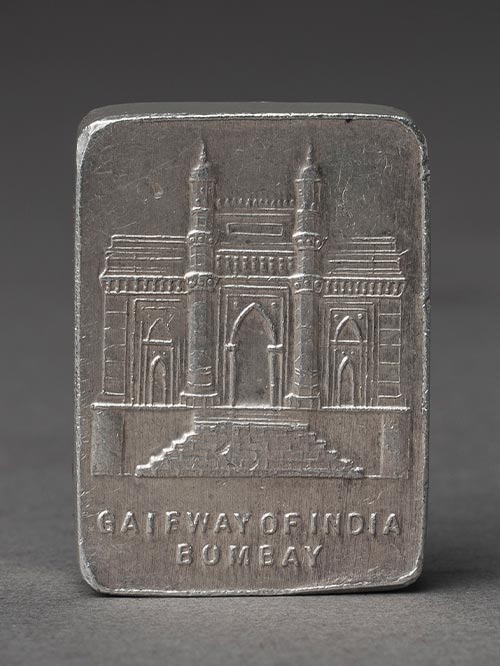
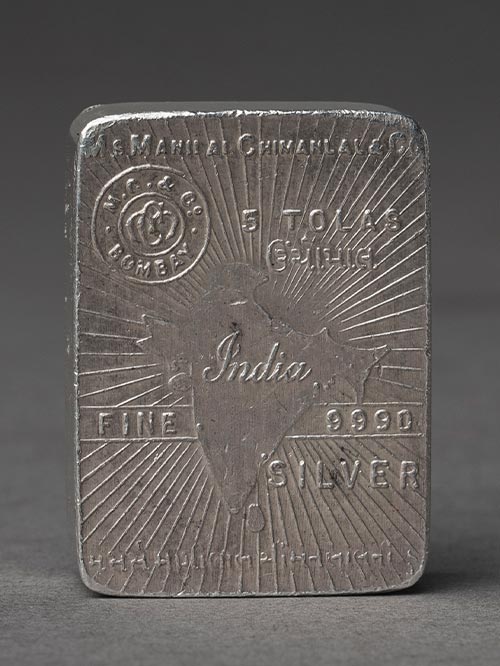
Manilal Chimanlal & Co., Bombay
Silver, 5 Tolas
This rare rectangular silver bar, dating from the late 1950s to early 1960s, depicts a view of the Gateway of India with an embossed caption on one side. On the reverse, there is a map of undivided India, accompanied by details including its weight (5 tolas) and maker’s mark. The term ‘tola’ denotes a unit of mass commonly used in South Asia, with one tola equivalent to 11.66 grams. Therefore, this bar weighs 58.3 grams. It’s noteworthy that the majority of such bars would have been melted down by the Indian government and recast.
Size (cms): 3(H) x 2(W) x 1(D)
Size (inches): 1(H) x 1(W) x 0.5(D)
-
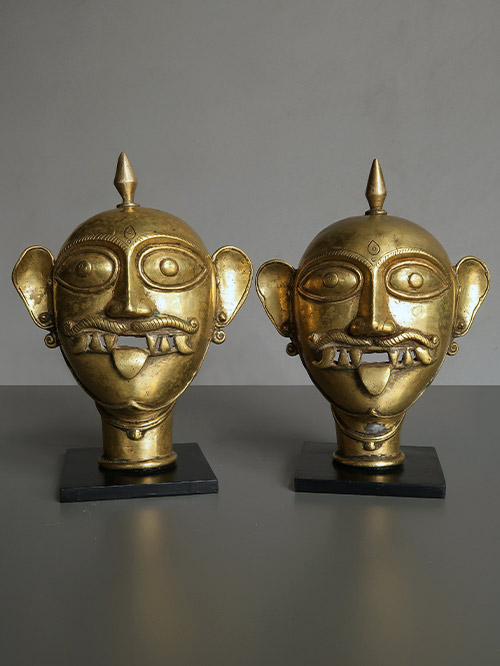

Karnataka
brass alloy
A beautiful pair of brass cast Bhairava heads also know as a ‘Demon Scarers’. Both visages are moustachioed with vicious gaping mouths with large teeth, fangs and protruding tongues. The heads have a rounded tubular extension at their base, which would fit over a pole and could be carried above the heads of the populace during festivals and processions.
Such monster figures and monster masks depict a demonic form of Bhairava, one of the avatars of Shiva. Some masks exhibited a distinct animal-like visage with huge teeth and a gigantic mouth. Those were often referred to as ‘tiger masks’. Some masks assumed the expression of a gargoyle with huge, bulging cheeks. Others incorporated composite features including tusks, bossing of the skull and occasionally the horns of a ram.
Protective deities such as viras (deified heroes), kshetrapalas (guardians), bhutas (spirits of various deities), including some daivas (devils) were expected to provide protection against invaders, thieves, the elements- fire , storms, floods, drought, disease etc. Since the earth was populated by gods and their counterparts in the nether world, demons, evil spirits and ghosts, prayers, offerings and sacrifices were made to both groups to propitiate them.
Size (cms): 29(H) x 23(W) x 15(D) each
Size (inches): 11.5(H) x 9(W) x 6(D) each













